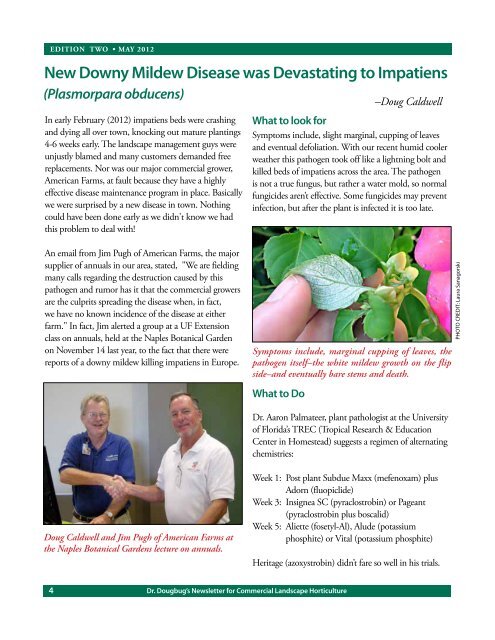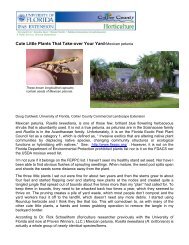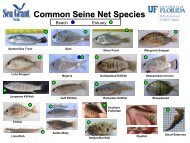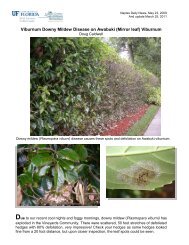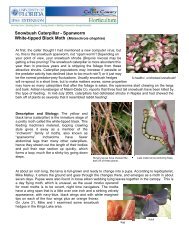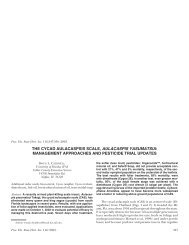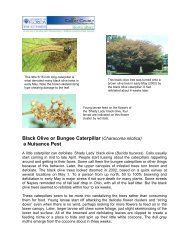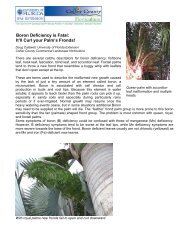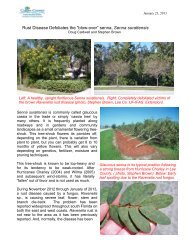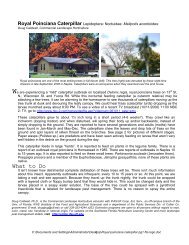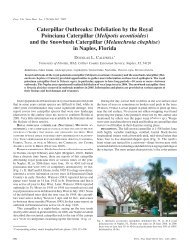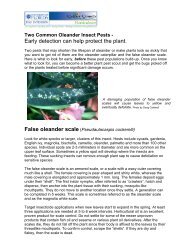bugs shrubs buzz - Collier County Extension Office - University of ...
bugs shrubs buzz - Collier County Extension Office - University of ...
bugs shrubs buzz - Collier County Extension Office - University of ...
You also want an ePaper? Increase the reach of your titles
YUMPU automatically turns print PDFs into web optimized ePapers that Google loves.
EDITION TWO • MAY 2012<br />
New Downy Mildew Disease was Devastating to Impatiens<br />
(Plasmorpara obducens)<br />
In early February (2012) impatiens beds were crashing<br />
and dying all over town, knocking out mature plantings<br />
4-6 weeks early. The landscape management guys were<br />
unjustly blamed and many customers demanded free<br />
replacements. Nor was our major commercial grower,<br />
American Farms, at fault because they have a highly<br />
effective disease maintenance program in place. Basically<br />
we were surprised by a new disease in town. Nothing<br />
could have been done early as we didn't know we had<br />
this problem to deal with!<br />
An email from Jim Pugh <strong>of</strong> American Farms, the major<br />
supplier <strong>of</strong> annuals in our area, stated, "We are fielding<br />
many calls regarding the destruction caused by this<br />
pathogen and rumor has it that the commercial growers<br />
are the culprits spreading the disease when, in fact,<br />
we have no known incidence <strong>of</strong> the disease at either<br />
farm." In fact, Jim alerted a group at a UF <strong>Extension</strong><br />
class on annuals, held at the Naples Botanical Garden<br />
on November 14 last year, to the fact that there were<br />
reports <strong>of</strong> a downy mildew killing impatiens in Europe.<br />
Doug Caldwell and Jim Pugh <strong>of</strong> American Farms at<br />
the Naples Botanical Gardens lecture on annuals.<br />
4<br />
Dr. Dougbug’s Newsletter for Commercial Landscape Horticulture<br />
–Doug Caldwell<br />
What to look for<br />
Symptoms include, slight marginal, cupping <strong>of</strong> leaves<br />
and eventual defoliation. With our recent humid cooler<br />
weather this pathogen took <strong>of</strong>f like a lightning bolt and<br />
killed beds <strong>of</strong> impatiens across the area. The pathogen<br />
is not a true fungus, but rather a water mold, so normal<br />
fungicides aren’t effective. Some fungicides may prevent<br />
infection, but after the plant is infected it is too late.<br />
Symptoms include, marginal cupping <strong>of</strong> leaves, the<br />
pathogen itself–the white mildew growth on the flip<br />
side–and eventually bare stems and death.<br />
What to Do<br />
Dr. Aaron Palmateer, plant pathologist at the <strong>University</strong><br />
<strong>of</strong> Florida’s TREC (Tropical Research & Education<br />
Center in Homestead) suggests a regimen <strong>of</strong> alternating<br />
chemistries:<br />
Week 1: Post plant Subdue Maxx (mefenoxam) plus<br />
Adorn (fluopiclide)<br />
Week 3: Insignea SC (pyraclostrobin) or Pageant<br />
(pyraclostrobin plus boscalid)<br />
Week 5: Aliette (fosetyl-Al), Alude (potassium<br />
phosphite) or Vital (potassium phosphite)<br />
Heritage (azoxystrobin) didn’t fare so well in his trials.<br />
PHOTO CREDIT: Laura Sanagorski


